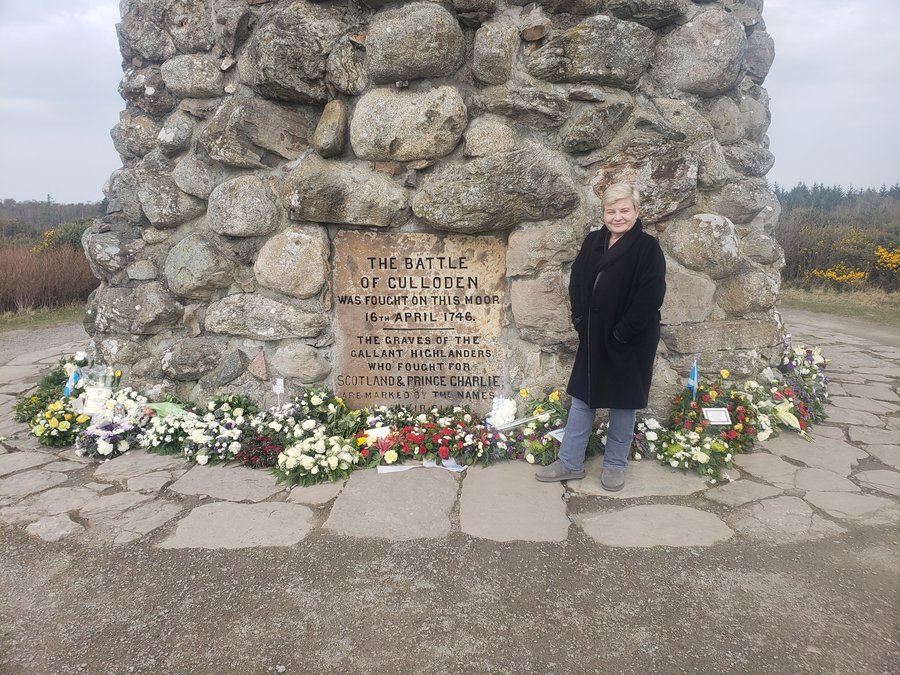I recently travelled to Scotland, where I spent some great times with family in the Scottish Highlands. I have happy memories visiting this part of the world as a young girl.
The April weather we experienced varied from snow on the top of the Cairngorms mountains (really) to sunshine and highs in the 50s in the town of Inverness. The stunning natural beauty of the area almost makes the challenging weather worth it! I have to admit that the frequent rain does contribute to the gorgeous green pastures, which in turn provide lots of grazing opportunities for the plentiful sheep and highland cattle.I have a bit of an obsession with the Outlander books, so went on a sort of Jamie and Claire odyssey. For the uninitiated, Outlander is a time-travelling romance that follows the story of Claire Randall, a married combat nurse from 1945 who is mysteriously swept back in time to 1743. Over time, she ends up passionately in love with Scottish Jamie Fraser, a brave warrior from this era.
The story begins with Claire entering a fictional stone circle called “Craigh na Dun,” which has magical powers and facilitates her time travel. This is said to have been inspired by a similar location that I visited near Inverness, the Clava Cairns, a huge mound of rough stones about 4,000 years old and built to house the dead in these ancient times.
It actually was a pretty spooky place, although Outlander author, Diane Gabaldon, clearly built on it with her inspired imagination. This prehistoric burial ground has remained a sacred place in in Northern Scotland for millennia and provides many clues to the beliefs of Scottish society back in the Bronze Age. There is more information at visitscotland.com.
Our next stop was Culloden, which overlooks Inverness and is where a crucial battle in history took place on April 16, 1746 – this battle and Claire’s knowledge of Scottish history is also central to the plot of Outlander.
As we approached the battlefield on a sunny afternoon, the visitor information signs reminded us that many war dead were buried here, perhaps a couple of thousand, and one which caught my eye stated, “Culloden was the last battle on British soil and marked the end of clan culture and was the harbinger of the Highland Clearances. It ensured the inevitability of the American Revolution and increased the outpouring of Scots across the globe.”
Wow, that is a big claim. How can this battle from the 1700s in the remote north of Scotland have “ensured the inevitability of the American Revolution?” Well, it takes a little explaining. The Battle of Culloden was the final confrontation of the “Jacobite Rising,” which began in 1745. This was an attempt to overthrow the House of Hanover (the English Royal family, who were Protestant) and restore the Catholic and Scottish- based House of Stuart to the British throne. Having failed in their attempt to gain support in England and advance on London, the Jacobites led by Scottish Prince Charles Edward Stewart (known widely then and now as “Bonnie Prince Charlie”) had retreated all the way back to the far north of Scotland at Inverness.
The well-supplied English king’s army was led by the Duke of Cumberland, son of King George II. His troops were in much better shape than the depleted, tired and half-starved Highlanders.
The day of the battle was freezing cold and raining hard, and the weather and marshy ground did not favor the poorly equipped Scots, who were bombarded with gunfire. When the Highlanders charged the English Redcoat soldiers, many died in the subsequent hand to hand fighting.
Today, flags and memorial stones mark the places where this took place and remind us that within less than an hour, the defeated Highlanders were forced to flee for their lives. Over the weeks that followed, many of the Jacobites that managed to escape the battlefield were hunted down and killed. Bonnie Prince Charlie himself was able to hide on the run for five months thanks to the support, bravery and help of the Scottish people, and then he managed to flee to France, never to return to the British Isles. This was the end of Scottish dreams to rule Britain and, worse yet, the English were harsh in their subsequent occupation of Scotland, leading many Scots to flee to both France and America.
The relatively high levels of Scottish immigration across the Atlantic, plus their long-standing animosity towards the English, were a significant factor in the march of the American colonies to seek independence. See historic-uk.com if you would like to know more.
There is much more to the history and geography of this beautiful country, but that will have to wait for another column. I sign off this week with a very accurate quote from American author and journalist Raymond Bonner: “If you don’t like Scottish weather, wait 30 minutes, and it is likely to change.” God bless America, and Scotland, too!



